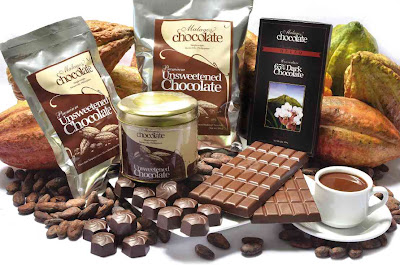Thursday, July 25, 2013
Why Malagos ‘tablea’ is extra-special
Malagos Farms is where the Puentespinas reign supreme. It is where they grow flowers, plants, fruits and vegetables that were thought impossible to plant, less thrive, in the tropics.
Charita Puentespina and sons Rex and Bo take care of the place. Charita and Rex call themselves farmers while Bo is a veterinarian who has volunteered his services to help save the Philippine eagle.
At the farm they raise ostriches for meat and a herd of “Bo-ang” goats (a cross between the bower and Anglo-Nubian breeds). From goat’s milk, Dr. Bo’s wife Olive makes gourmet cheeses. They even make their own sweet wine made from Asian currant bignay, which pairs perfectly with the cheeses.
To their already very impressive list of homegrown specialty food products, they’ve now added chocolate.
Their interest in chocolate production began when Charita decided to lease a farm at the back of their house in 2003. The farm had existing cacao trees that she rehabilitated. When they bore fruits, she harvested the cacao pods and made tablea the traditional way—roasting the beans using firewood, grinding the roasted beans using a fabricated grinder, and molding them into round tablets.
In December 2007, a cocoa sustainability team from Mars, the maker of M&M’s, approached the Puentespinas to set up the Mars Cocoa Development Center. Part of the farm is now a laboratory for farmers to learn good agricultural practice on the production of cocoa.
What makes their chocolate special, according to Rex, is that the “beans are from the Trinitario hybrid (a cross between Criollo and Forastero), considered the finest cocoa beans in the world.” They are fermented to enhance its flavor, dried in specially made solar driers, and sorted following international standards.
Single-origin cacao beans
“Our cacao beans are of single origin, grown in one single area or region,” said Rex. “Cacao beans sourced from only one particular region carry with them a more distinctive and pronounced taste—similar to wine, where the distinct flavor and taste are related to the area where the grapes are grown. Artisan chocolate-makers worldwide know the value of single-origin chocolate.”
He added: “Our cocoa liquor is 100-percent pure.” Laboratory test results show a high fat content (55.7 percent), the reason why it easily melts. The quality is reportedly comparable to leading brands in the world.
The family also invested in equipment to improve the process and the quality of their product, now known as Malagos Chocolate.
In the process of perfecting it, Rex sent me sample after sample of their chocolates for me to test and try. As each batch came, the process just kept evolving, so that product has become better.
One rainy day, I decided to cook champorado using a can of Malagos tablea.
Champorado cooking has never been the same since. The quality and taste of the Malagos tablea gives the champorado a totally different character. Capped with all sorts of delicious toppings, it is an uber sinful porridge that’s sweet, salty, a tad bitter, creamy, silky, with a wine-y, earthy chocolate finish. Malagos tablea is deliciously world-class and proudly Philippine made!
The chocolates come in two variants : Malagos Premium Unsweetened Chocolate (100 percent pure chocolate) for cocoa-based drinks and for baking; and Malagos 65 percent Dark Chocolate, to use as couverture for pastry and, of course, for eating. As you read this, Malagos is wrapping the first batch of 100-gram chocolate candy bars.
Join the Puentespinas for the product launch and baking demo by my dear friend, chef Jill Sandique, on July 31, 3-4 p.m., at World Food Expo (Wofex), World Trade Center.
For inquiries, call Rex Puentespina at 0917-5262365.
I am sharing with readers the champorado recipe I taught during my Merienda class.
Champorado
2 c good-quality glutinous rice, rinsed and soaked for an hour, drain
4 c coconut milk, second extraction
3-4 c water (quantity of liquid will vary depending on desired consistency; adjust accordingly)
2 pandan leaves, tied
Pinch of salt
1/3 c sugar
1 can Malagos unsweetened tablea
½ c coconut cream, first extraction
Combine all ingredients except sugar, coconut cream and chocolate.
Cook, mixing occasionally to make sure the rice doesn’t stick to the bottom of the pan.
Once the rice grains are cooked, add sugar and the tablea. Once the tablea melts, finish with kakang gata.
Cook an additional 8-10 minutes.
Serve champorado with:
Milk—Combine ½ cup each of evaporated milk, condensed milk and cream. Mix and drizzle over champorado. (I serve my champorado with a combination of milks plus cream. It gives it a different consistency and richness.)
Tuyo—good quality tuyo, fried and flaked
Tapa—1 kilo sirloin, sliced thinly and pounded with a meat tenderizer to 1/8 in. In a bowl combine and mix well: ¼ cup light soy sauce; 3 tbsp brown sugar; 1 tbsp white sugar; 1/3 cup pounded garlic; 2 tsp Worcestershire sauce; 2 tsp Knorr; 1 tsp red pepper flakes; 2 tsp each of vinegar, onion powder and cornstarch; 1 tsp salt and fresh pepper. Marinate meat a few hours. Cook tapa and slice into strips.
Chicken skin—Marinate ¼ kilo chicken skin in 1 tsp salt, ½ tsp pepper and juice of 1 kalamansi. Dredge skins in cornstarch, shaking off excess. Steam skins for 5 minutes. Cool, deep-fry and crumble.
Fried shallots: Soak 1 cup thinly sliced shallots in cold water with salt for 1 hour. Drain. Deep-fry.
Oil of choice
Speaking of deep-frying, I kitchen-tested Magnolia Nutri Oil “Blue” and I’m very pleased with the results. Considering that I was cooking chicken dredged in cornstarch, I was able to fry a large quantity in succeeding batches without changing the oil. And the chicken did not have a single speck of burnt starch on it. Magnolia Nutri Oil “Blue” has become my oil of choice for frying.
For my new cooking class schedule, call Ann at 0908-2372346 or 4008496; Mai at 0917-5543700, 6475683; Mai or Arnel at 9289296 or 9273008.
source: lifestyle.inquirer.net

